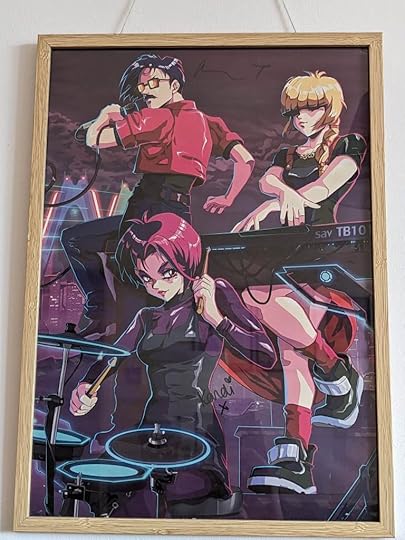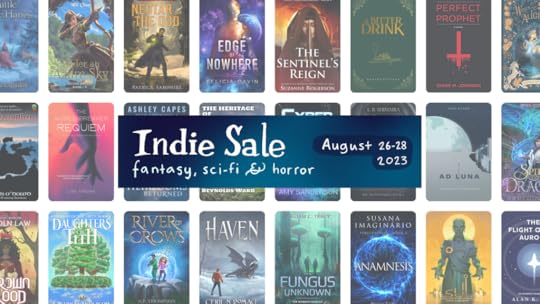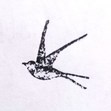Hûw Steer's Blog, page 13
October 22, 2023
What Have I Been Doing: October 2023 Edition
Right. Hello. Been a little while. There’s good news, and less good news.
The good: within a couple of weeks I should be able to finally be able to tell you about at least one, and hopefully two, of my upcoming short stories. One launch party is scheduled for early November, and while I don’t have a date for the other, it should be in the October/November issue of said magazine, so fingers crossed…
They’re both pieces I’m rather proud of, so I’m excited to finally be able to share them with you. And next year, even more…
I’m also fairly pleased with the second instalment of my snappily titled ‘Experimental Choose-Your-Own Adventure Story Thing’, which concluded last week. There will be another. It’s quite fun to put together. Even if you missed the live unfolding of this tale, it still should be a bit of fun to read, so check it out. Writing in second person is weird but cool.
Onto the less good, then.
Last time I did a big update, I said Boiling Seas 3 was still on track to be out this year. And I have been making progress, good progress, even. I had a week off in September and I not only wrote over 6000 words, I came up with a title and made a cover! (To be revealed later, don’t get overexcited.)
But there’s a lot still to do. A lot. I’m approaching the end of the narrative, but that doesn’t mean the book is anywhere near done: there was already a lot of editing and trimming that needed doing, and given the current and ever-expanding length of Part 3, there’s going to be an awful lot more. And then it needs proofing, and I need to do those edits, and all the formatting and KDP nonsense…
I’m going to finish the manuscript this year. I am holding myself to that. It’s not quite close enough to taste, but I can smell the end for certain. As for getting it published and in your hands before 2024? At this point, that’s not going to happen. I’m sorry. Writing the end of a trilogy, it turns out, is bloody hard work. I won’t make any promises about a new release date, even a vague one, for that way lies Rothfuss madness. But next year looks good. Next year I can do.
Again, sorry. I want this book to be good. I’ve put too much of myself into the Boiling Seas to let it end badly. I owe you that. I’m just sorry it’s taking so long.
BUT.
That doesn’t mean I’m not publishing a book this year. For I have taken my tiny red hammer, broken the glass case, and dusted off the Backup Novella. And that will be coming out very soon indeed. The text is pretty much ready to go, awaiting one more reader to let me know if it’s decent (so far, so positive feedback). The cover is ready. I’m basically tinkering with the title, and then I just need to format the hell out of it and hunt down as many people who might like to review it as I can. (If you are one of those people, let me know!)
 Who could they be? Wait and see..
Who could they be? Wait and see..It’s a bit of a change of pace for me. It’s a slower, quieter story than I usually write. There are no battlefields, no daring escapes. Instead there are… people, living their lives, in a place that should be very peaceful indeed. It’s a bit different. But honestly, I think we all need a little peace and quiet now and then.
Once I’ve got a title nailed down, I’ll tell you all about it. Until then, stay tuned.
October 15, 2023
Another Experiment, Part 6 – The Cave
Down we go, then. That was inevitable.
You fashion another torch. It had better be warm down there, given the ruin you’ve not made of your shirt. Steeling yourself, you haul open the trapdoor – it is heavy, thick wood bound in iron that seems even stronger than the main doors to the tower. Your fingers slip as you try to lower it closed carefully and the door crashes loudly back into its frame. It is like a thunderclap, and you wince both in pain and frustration. If anyone, or anything, is listening for you out there in the mountains, they certainly know where you are now… to say nothing of anything that might be down here in the cellar. You push the heavy metal bolt across, locking the world out… and yourself in.
The guttering torchlight reveals more stairs, and you pick your way down cautiously. The stone is worn, but not unduly so, and unlike the tower above this stairwell is walled on both sides, rather than being open on the inside to whatever basement lies below you. The steps spiral down in the same curve as above, though – you are very much still within the tower.
You press on. After a few revolutions of identical grey stone, one of the iron sconces in the wall turns out to still contain an unlit torch. Its oil is long dried, but the cloth wrapping still catches, and you climb on with a little more confidence and a much steadier light.
You turn and turn for what seems like forever – what seems like far too many stairs to lead to any ordinary cellar – before the stairwell ends in another door. It is closed, and the door itself, though old, is just as strong as the trapdoor above. With nothing else to do, you push it open carefully, and step through.
 From a photo by Julian Hochgesang (Unsplash)
From a photo by Julian Hochgesang (Unsplash)You were expecting a dark cellar, disused, and, knowing your luck, with something unpleasant already living there and waiting for you. You were not expecting this. Before you, yawning, so wide and tall that you can barely make out the walls and ceiling, is a cavern that could swallow a small city. Stalactites the size of buildings dangle above the mirror-smooth surface of an impossibly vast lake, dark and deep beyond imagining. From where you stand, a series of steps – not natural, but deliberately hewn from the dark stone – lead down to the lake’s shore, where what seems to be a cluster of buildings sit, next to a small jetty. And you can see all this, because your paltry torchlight has been augmented by the pale glow of a strange, beautiful lichen that clings to the walls in great vein-like strata, branching and joining in an infinite pattern as bright as the stars in the night above you.
It is a wonder the likes of which you could never had dreamed, and the sight of it invigorates you. You bound down the steps – then slow to a careful walk, the rapping of your boots echoing sacrilegiously from the cavern walls – past tall and silent statues draped in hooded stone robes. Looking back, you can see tunnel-mouths in the cavern wall behind you with doors of their own. Where might they lead? How many entrances to this place are there, hidden in these mountains and even beyond?
There are indeed buildings at the bottom of the stairs. They are completely empty – not even a stick of furniture or the crumbled corner of a tapestry remain in any of them, and you search thoroughly. Whatever might have lived here is long, long gone. The complete lack of sound, save for your own breathing and movements, is eerie.
But at the jetty, there is a boat. It is larger than the one you took down the river, broader and more stable. There are oars, too, but an instinct makes you first toss a scrap of wood from your torch into the lake-water, sending ripples coruscating out. You watch closely. Though the surface of the lake appears still, the wood floats slowly away, out towards the centre of the lake, and whatever might lie at the other end of this huge cavern, too far away to see. You will not, you realise, need to row just yet. Though it is made of wood and clearly very old, the boat is in perfect condition, varnished and sealed to perfection.
Nothing has changed in this place for a very long time, you realise. Nobody has been down here. Nobody has so much as breathed this air.
There is only one way to go.
You climb into the boat. You settle your pack at your feet and, using one oar, push off the jetty into the water. You make a few desultory strokes at the water, but the hidden current has you quickly, and you stow the oars to simply let yourself float on. You smile to yourself. Twice in two days, you think. I’m making a habit of this. But this boat is not pursued by bandits. You have supplies, you have the means to stay warm. You might have no idea where you are going, but at least this time you will not be helpless when you get there.
You settle back in the boat, and let the current bear you on, by the light of false stars.
And that’ll do for this instalment, I think. I’ll pick this up again sooner than last time; it’s a fun exercise for me and it seems like you lot enjoy it too!
Thank you to everyone who threw in a vote on the outcomes, and everyone who just read on and enjoyed. We’ll have to wait and see what happens next…
October 8, 2023
Another Experiment, Part 5 – The Tower
There was one vote to stay in the woods, and one vote to take the ruined north road. But it’s Spooky Season, so…
It’s lucky that the moon and stars are bright above you, because the old road is old, and treacherous beyond belief. It was paved, once – every so often a patch of intact stone slabs gives you a glimpse at the broad highway that must have once stretched down all the way to the river. But years of wind, rain and presumably theft of what looks like a solid building material have left this once-grand road in tatters. You trip and stumble across shattered stone, over holes in the earth beneath, across heaps of loose, broken stone.
This is not just the toll of years, you realise. This road was deliberately broken. Below the fisher’s dell, there is no trace of it at all.
But you forge on. You pause for a while to sit atop an old milestone, its inscription long since worn away, and eat more of the food the fisher gave you. Somehow, despite all your day’s travelling, despite the lateness of the hour, you feel invigorated. Perhaps it is the food, or perhaps it is that, for the first time in several days, you are travelling without feeling actively chased. No torchlight follows your path, no wolves howl in the night… yet. Nobody is on this road but you.
It is cold, though. You are not quite in the mountains themselves, but the slope you walk on cannot really be called a foothill anymore; it is rocky and growing steeper by the yard. But the ruined road continues on, and, for lack of anything better to do, you follow it. It must lead somewhere, you think. To something.
And it does. It looms from the dark, but subtly: the stone is the same hue as the shadows that surround it, and even in the moonlight you only see it when you are right outside its doorway: a tower, in surprisingly good condition, save for the half-collapse of the topmost floor and a few gaps in the lower wall. It is three floors tall, slender and well-built. Its door has long since crumbled away, leaving a few long, splintered bits of old wood on the floor, the only barrier against the darkness within.
Well, you think, I’ve come this far.
 Photo by Félix Besombes (Unsplash)
Photo by Félix Besombes (Unsplash)With the flint and steel from your pack, some of your ragged shirt and one of the bits of wood you improvise a crude torch. Guttering firelight reveals little more than dust and echoes in the atrium, save for the remnants of what might have been furniture, and webs that must have belonged to some truly gargantuan spiders. The immediate ceiling has collapsed, leaving more scraps of wood across the floor. But it is, at least, inside.
There are stairs. They lead up, curving against the outer wall, all the way to the stone ceiling at the top of the tower. You would have a good vantage-point to look down the mountainside from there, but any fire you lit – and you will need one for the night, this high above the world – will be clearly visible. To who, you do not know, but the thought of it makes you uneasy. You could, instead, just settle down here for the night. There is enough scrap wood to keep you warm. But you would be vulnerable, with the yawning door before you and no real view to the outside. Maybe you could build a barricade, but the thought of that exposure still does not strike you as pleasant.
Something howls in the night, far away… for now.
But the stairs go down, too. Down, into the earth below. There is a trapdoor, still intact. Gingerly lifting it, you see that there is a strong bolt on the inside, that would hold it firmly closed. Nothing would be able to get in.
But was something not meant to get out?
The top of the tower, the atrium, or whatever lies below. Where will you go?
Let’s have some votes, then.
October 1, 2023
Another Experiment, Part 4 – The Hills
Votes were to run away. Sensible.
The spear wavers, just for a moment, and you make your leap, diving back through the window and crashing headfirst into a little vegetable garden. Earth goes everywhere; what feels like a carrot jams painfully into your ribs, but it is far less painful than the spear that lances down through the window and skewers a ripe turnip cleanly through the middle. The old woman jerks it back, snarling in outrage.
“Get out of my bloody garden!”
You scramble to your feet, covered in soil and damaged leaves picking your way out of the garden as fast as you can, while trying to crush as few plants as possible. The spear jabs at you once, twice – and then the old woman is gone from the window, stomping noisily away. You hear a door slam shut. She might not want to climb out of the window after you, but she is still coming. You stumble out of the garden and cast around for an escape. It is uphill or nothing; either you try to run out across the hills or make for cover in the small wood in the other direction. The thought of that bright spear flashing through the air decides for you: hide in the woods, and avoid being skewered.
You scramble up the side of the slope and into the trees, not daring to look back, though you can hear the old fisher cursing either at you or at the damage to her vegetables. The trees themselves are tall, thin things, though they are denser further into the wood. The floor is covered in bracken, and you dive into a thick patch of it behind one spindly tree. You hold very, very still. Leaves prod you uncomfortably in every exposed bit of skin, wet earth from the garden is everywhere, and the sun is almost entirely down. You are cold, and damp, and afraid.
You wait there for what seems like forever, but is only really half an hour. You let the sun set and listen intently, for any sound of the woman with the spear, but there is nothing – until you hear a throat being cleared, down below.
“You can bugger off,” the old woman calls. “But don’t starve. Don’t want you bringing those crows back.”
There is a thump, as something hits the ground, and then the sound of a door closing. You wait a little longer before standing, letting half a forest fall from your ragged, filthy clothes, and pick your way to the edge of the wood to look down into the dell. The cabin door is firmly shut, the only light that of the fire inside leaking through closed curtains. In the rivulets of light that leak through the closed front door, you see a small pack dumped at the edge of the porch.
Carefully, quietly, you pick your way down to the door, and take the pack. It is only small, but inside you find a waterskin, half a loaf of hard but edible bread, and strips of something that turns out to be fish – so salted that it is almost unrecognisable, but still filling. There is a flint and a small piece of steel, too.
You debate calling your thanks, but decide against it. The fisher has clearly had enough disturbance for one day.
 Photo by Merri J (Unsplash)
Photo by Merri J (Unsplash)You take the pack and climb back out of the dell. The sun is down, but the air is clear and cold up here in the hills, and the moon and stars shine brightly. In the distance to the west you can see a dim golden light – whether it is the setting sun or the lights of some settlement, you cannot tell. You will certainly not be able to reach it tonight, but you could make a start, and sleep under the stars.
The woods above you were sparse at their edge but became thicker and far darker further in. There is wood there for a warm fire, but you will have to go in deep to find enough and to stay out of the old fisher’s way. The embrace of the trees will shelter you… but it could well shelter other things, too.
The mountains loom to the north. You almost dismiss them – it is getting too dark to attempt a further climb. But something glinting in the moonlight catches your eye. It is stone: not mere bare rock but worked, carved stone. Walking a little closer, you can see that it is the stub of an old milestone, at the edge of what had seemed to merely be a fall of scree but now appears to be the last remnants of a very, very old road. It winds further up into the mountains, swiftly disappearing from view. Where it leads, you cannot tell. But it might lead to something, even if it is a half-fallen roof to shelter beneath.
Towards potential civilisation; to certain, if dubious shelter in the woods; to gods-know-what in the higher mountains.
Where will you go?
Let’s see your votes in the comments.
September 24, 2023
Another Experiment, Part 3 – The Fisher
That’s two votes for the honest approach. What law-abiding readers you are.
You walk into the porch, to the door, and knock. The sound echoes around the dip in the landscape, hard and harsh as breaking bone. But there is no reply. You knock again, harder, but when the echo fades there is still no sound at all. You press your ear to the door, and hear nothing at all.
“Hello?” you call. Still nothing. It makes you deeply uneasy. If there is smoke rising from the chimney then there must be someone here – or there was recently. Perhaps they are out – but where is there to go around here, save all the way back down to the river – a journey that took you hours, and would have taken the owner of this house directly past you on your way up? You spare a glance for the thin trees that begin to encroach on the top of one slope, the outriders of a patch of woodland beyond.
“Anyone home?” you call again, louder. Even in the woods, someone would be able to hear you shouting this loudly. Hell, they can probably hear you in Whetstone, wherever it is. A chill runs down your spine at the thought of the bandits you evaded in the woods, and whether they might be on your tail – but, whirling, you see nothing behind you.
The sun is beginning to caress the horizon. Night will be coming, and the chill of the mountain air is beginning to overcome the sweaty heat of your exertions. You need shelter.
A last knock still produces no sound. Better to ask forgiveness than permission. You push, and find that the door is unlocked.
Inside, the cottage is dark, save for the pool of dim, ruddy firelight spilling from one doorway. There are hooks for lanterns, candlesticks, even something modern and alchemical, but all are extinguished. You step forward, trying, for once, to be loud and obvious.
“Hello?” you call again, more softly now. The dark hall is oppressively narrow. Stairs lead up to a low attic floor above, but you head for the firelight, drawn in like a moth. Pushing open the half-ajar door, you see a room clearly built for one: one old armchair, one wooden stool at a small table, a single plate and tankard next to the sink in the little kitchen to one side. The fire is burning low in its hearth, but there are still small flames, not only embers. It was fed, and fed recently. But there is nobody in the chair.
 Photo by Stéphane Juban (Unsplash)
Photo by Stéphane Juban (Unsplash)You are weary, and there is no-one here. You go to sit down in the chair – and stop, because the cold, sharp object poking into the small of your back makes you suddenly, painfully awake.
“You hold still, there,” comes a gruff voice from behind you, and you slowly raise your empty hands.
“I don’t want trouble. I did knock.”
“Don’t much care if you brought flowers,” the voice replies curtly. “Going to step back. You’re going to turn round. Slow.” The metal point withdraws, and you turn around as ordered.
Standing behind you, more than a little demonic in the ruddy firelight, is a woman who might as well have been carved from teak. Her hair is iron-grey, her eyes dark and narrow, her skin as weathered as a mountainside. The spear in her hands is short, but gleaming. Its long head is barbed and narrow. A fishing-spear, you realise – and one held by a woman who very definitely knows how to use it.
“I really don’t want trouble,” you say, even as the woman steps slowly towards you, forcing you back across the room. “I came from the river. I saw your fire. I –”
“I wanted company,” the woman says, sharply as her spearpoint, “I wouldn’t have come up here.”
“I’m just a traveller,” you protest.
“That’s what the last lot said.” You do not think it wise to ask what happened to the ‘last lot’ – but there is certainly no sign of them anywhere here.
“I just need shelter,” you say. “That’s all. It’s cold out there. Please.” You have been forced back almost to the wall, now, between the fireplace and the window – ajar, you see, with a quick flick of the eyes. Your leg brushes something metal, and you can feel something like a handle pressing into your thigh. Was there a poker there before?
“What you need,” the woman says, “is to leave. You leave on your own, or I make you.”
You could try and talk things out. If you can explain exactly what brought you here – assuming you live long enough to tell the tale – perhaps the woman will show a crumb of sympathy. You are no threat, after all. Trying to fight those bandits proved that.
But the woman is old. She holds her spear tightly, but there is just an imperceptible shake; though her eyes are hard as flint, there is a sheen of cataract over them. The poker at your side feels heavy. It is close enough to grab.
On the other hand, the window at your other side is ajar. You could make a leap for it, into the garden below.
Talk, fight, or run. What will you do?
Just because you were polite doesn’t mean everyone is going to be polite to you…
Votes in these comments, and we’ll see what happens this week.
September 17, 2023
Another Experiment, Part 2 – The Cottage
2 votes to go into the hills – so here we go.
Through a combination of tactical rocking and desperate paddling, you manage to bring your boat close enough to a rocky outcrop to scramble onto the riverbank. Before you can drag it ashore, the current has carried your little vessel back out into the river and away, down into the valley ahead. Well, you think, no going that way now.
Glancing at the path back along the riverbank, you turn instead towards the hills. The mote of smoke is still visible against the clear sky, though it is faint and pale. It could easily have been a cloud, if the rest of the sky wasn’t bright and blue.
You begin to walk.
The path is rough and old: it is clearly not a made thing but a path worn by generations of trudging feet, carving a shallow furrow into the earth and driving away the grass and moss. It is as straight as such a path can be, veering only for rocks or other obstacles. Someone, you gather – or many years of someones – has taken the shortest possible path to the riverbank and back, day after day after day. Hopefully, there is still a someone at the other end.
It is hot, the afternoon sun beating down from the clear sky. You are sweating before you even reach the proper hills, your legs aching by the time you crest the first rise. You hope you will not have to walk all the way up into the mountains that loom beyond the foothills before you reach the source of the smoke. But you can see the plume becoming clearer, and the path still points straight towards it.
You keep walking.
The sun is much lower in the sky by the time you crest the final rise. The mountains are a great deal closer now; you are as tired from this afternoon’s climb as you were from days of walking through the forests to the east. But you grin, because before you, nestled into the dip between two hills, is a house.
It is little more than a cottage but it is well-built, with wooden walls and a proper shingled roof. You can see a fence behind it describing some sort of paddock or garden, but cannot make out anything in it besides some sort of leafy plant. In the front porch, there is a bundle of rods and nets and hooks – fishing gear, clearly well-used, and explaining the track down to the riverside.
 Photo by Bas van der Horst (Unsplash)
Photo by Bas van der Horst (Unsplash)But there is nobody in evidence to use it. There is no sign of movement at the windows or nearby – and the windows themselves are dusty, not cleaned in a long time. One, on the side, is hanging off a single hinge. There are weeds growing through the steps up to the front door. And yet, from the stubby chimney, smoke rises still.
Your stomach rumbles. You are tired, hot and hungry, and this is the first hint of civilisation you have seen all day.
You could look around the back of the house, to see if anyone or anything useful is there. You could simply knock at the front door and present yourself as a weary traveller… or you could climb quietly through the open window, and try your hand at sneaking.
What do you do?
An open approach, a curious one, or… well, crime? All up to you. Votes in the comments below.
September 10, 2023
Another Experiment, Part 1 – The River
You are so deeply asleep that it is not until the bird on your chest gives your face an experimental peck that you wake. You jerk up, sending the bird squawking away into the air. The motion rocks the tiny boat in which you sit alarmingly, and you spend some moments trying to stop your vessel from capsizing.
Eventually you settle, and look around. It is around noon, the sun high in the sky. You are floating down a broad, deep river, winding its slow course through rocky ground broken by a few small stands of trees. The scrubland looks to extend in all directions, almost as far as you can see; there are mountains to the north, and behind you, to the east, you can just make out the shapes of trees, of a forest now many miles distant – the forest in which you came across the inn, and the bandits, and fled from them in this tiny stolen boat.
 Photo by Martin Sanchez (Unsplash)
Photo by Martin Sanchez (Unsplash)The last thing you remember is hunkering down in the bottom of the boat, tired and battered and afraid. You must have floated away from the bandits who were chasing you – you’re still in one piece, after all, and when you examine the stern of the boat you see a broken-off crossbow bolt, embedded just a few inches from where your head was resting. So, you think, at least I’m alive.
But you are hungry, and filthy, and your many bruises ache. You have a few coins in your purse and precious little else. The tiny boat has no oars and no sail. You have been floating for hours along this river. You have no map, only the sun to give you direction, and no idea where you are.
Thinking back, you recall a signpost: to the west of the forest was a town, called Whetstone. You cannot see a town behind you, but the rise of the land might be blocking it. You have no idea how far you have floated from the forest. Whetstone could be just around the next bend in the river… or it could be miles behind you already.
You risk standing, balancing precariously in the little boat. Peering at the riverbank, you can see not a road, but at least an old and very worn track. It follows the riverside as far back as you can see. Ahead, it appears to turn away into the hills. You can see nothing at its end, except, perhaps, the faintest hint of what might be woodsmoke.
Ahead, the river flows on, into a landscape that seems to dip – a valley, perhaps; a way down from the hills through which this river flows. Whether it is Whetstone or not, perhaps there is a town or village down there, where you can seek food, shelter or even work.
You are sure that, with a bit of effort, you could bring the boat to the riverbank and continue on foot, even without oars.
You can beach your boat, and then either backtrack along the path, to see if Whetstone is behind you, or follow the track into the hills and the hint of smoke. Or you can sit where you are, and see where the river takes you.
What will you do?
Let’s try this again, shall we? Cast your votes for a course of action in the comments below: I’ll tot them up next week, and we’ll see where this story takes us.
What happens next is up to you. Choose wisely.
September 3, 2023
Discovering the Internet, Via Badger
Twenty years ago yesterday, my eyes were opened.
I was in primary school, because I was seven and I suppose I had to be, as were all my friends. These were the hallowed days of the ‘IT Lab’, a sacred room full of clunky old PCs in which we were taught How To Computer (extraordinarily basically) and sometimes allowed to just do whatever we liked. Which meant that, back in September 2003, we were all messing around with WordArt (RIP Jokerman) and the like when someone burst in, eyes wide, with something along the lines of ‘Guys, you have to see this.’
And ‘this’ was this.
MrWeebl, 2003On its own, this was, to a 7-year-old, phenomenal. A silly song about dancing badgers? Absolute perfection. We all watched it on loop – because these were the days before YouTube, the days of glorious infinite Flash loops – for as long as we were physically allowed to, and then as soon as I got home I instantly dragged my dad to the computer and showed him too. He professed to enjoy it, as dads do – but he, being less entranced by badgers, snakes and mushrooms, spotted something else. He spotted the ‘More Toons’ link in the corner.
And so we clicked it. And the Internet unfolded before me, a rich tapestry of silly videos and silly games and just stuff – because that link took me to Weebls-Stuff, home of Badgers, and the Moon, and Magical Trevor, and so many more things besides. It was everything I’d ever wanted and never knew, and I sprinted into school the next day to share the wonder with everyone else.
This was the moment, for me, when a computer went from ‘electric box that does stuff’ to the marvel that it really was. Weebls-Stuff was my portal to the Internet for years. I devoured everything Weebl made – and more, because these were the days of individual website and re-hosting, so there were plenty of other creators there too. Salad Fingers, Cyriak Harris – the list goes on. I know it sounds like an exaggeration, but this was genuinely one of the moments when I, a small child, realised there was more to the world than the sleepy country hamlet where I lived. And it came in the form of dancing badgers.
It’s been twenty years and a day since then. The Internet has changed. YouTube is where videos live now, of all kinds (which, while convenient for the viewer, is hell for many creators). Flash is dead. The landscape I look out on now is very different to what I saw aged seven: concentrated in great city-websites, with the wilderness and countryside home to fewer, but darker things.
But Weebl is still going. He’s making fewer silly toons, but he’s branched out into some great electronic music with Savlonic (and who would have thought that a silly video for ‘Electro Gypsy’ would turn into half a dozen albums?). I met him a few years ago at MCM when I was stewarding; he’s a lovely bloke.
 Signed by the band themselves. It’s seriously good music.
Signed by the band themselves. It’s seriously good music.It has been twenty years. And so, yesterday, the badgers came back.
MrWeebl, 2023It’s a celebration of a very funny man with a fantastic career. But for me it’s more than that. It’s a celebration of the thing that brought me the Internet, of a thing that expanded my horizons beyond the ordinary and into the seriously daft. It’s a very silly thing, but it shaped me into the very silly man I am today.
So cheers, Weebl. Long may you reign, king of the Internet.
(Now please bring back On The Moon and Magical Trevor.)
August 27, 2023
Young Minds
First things first: there’s a big indie book sale on at Narratess, today and tomorrow. Much fantasy, SF and horror is available for cheap/free – including my own Ad Luna and The Blackbird and the Ghost, as well as many SPFBO and SPSFC winners and contestants, which are Excellent. So go buy some books.
I’ve just finished a long August-and-a-bit of summer workshops at my charity job, which has been a lot of fun, and absolutely exhausting. (Seriously, you try taking two dozen kids around London Zoo on a hot day. And we had to bring them all back.) But among LEGO sessions, printing, magic and singing (which I helped run purely because I happen to be in a choir and not through any actual music-teaching skill), there was one workshop that stood out a bit. It was last week’s creative writing session.
I’ll clarify immediately that I was not in charge of this workshop – while I can write myself, and I might be able to vaguely teach or help a particular audience of writers, two dozen 5-8 year-olds is not that audience. I was instead assistant to the lovely Filiz, who runs our regular creative writing workshop and, being an actual teacher, is a lot better at this sort of thing than me. We sat the kids down, and Filiz broke out a bevy of prompt images and worksheets, guiding the kids step-by-step through making a character, thinking up a plot and actually starting to write down a story (we were only there for a couple of hours, and herding children is much akin to herding cats, so no full novels were churned out).
Obviously some of the kids were much more into the activity than others, and obviously they all worked at different speeds – but there were some genuinely great ideas in there. I read the opening of a murder mystery, the outline of a horror story, quite a few stories about elves having nice lunches in the garden, and the start of a Zeus-centric fantasy story that I’m really hoping I get to read more of. More than a few eagerly took their notes home at the end of the day to keep writing.
And as I sat and helped, I really appreciated the structure of the whole thing – by which I mean the actual story structure worksheets and the process Filiz laid out. You started with a prompt image and accompanying questions – who might live here? Where is this place? – before drawing up a main character (literally, because coloured pens). Then off to the narrative structure sheet, which I’m actually going to have to borrow a copy of for myself, because seeing the basic structure of a story laid out – establishing setting/character, introducing conflict, resolving conflict, concluding – hammered home how much I don’t pay conscious attention to that when I’m writing, and how much I definitely should. I was sitting next to a 5-year-old with a better grasp of basic story structure than I had.
And it was all wonderful to watch. Even the kids who started the workshop with an ‘I hate writing’, etc. were in the thick of it by the end, and the ones who really loved writing had to have the pencils forcibly taken out of their hands at home-time. 3 or 4 of them have told me that they want to be authors, and I reckon they could absolutely do it.
I wrote something myself, too, of course, which I’ll pop up here when it’s done. Grommit the dwarf (thank you, children, for that name) will have his day in the sun.
But it was a very affirming thing, to watch all these young minds get stuck into writing.
And, finally, go buy some books.
August 25, 2023
Narratess Indie Sale
For a second time, the lovely Tessa at Narratess has put together a truly massive sale of indie sci-fi, fantasy and horror books this weekend.

And you may spot, hiding in there, a familiar cover or two…
Ad Luna is a mere £0.99, and The Blackbird and the Ghost is free, all weekend.
Get some good books, leave some reviews, and generally have a good time.



